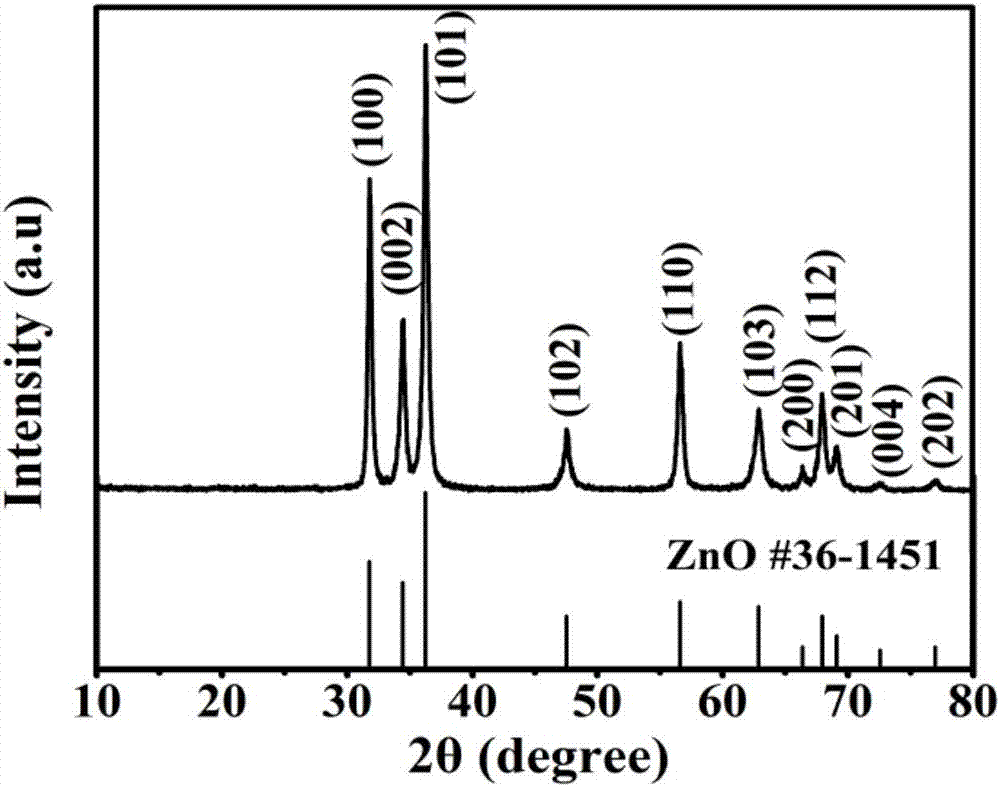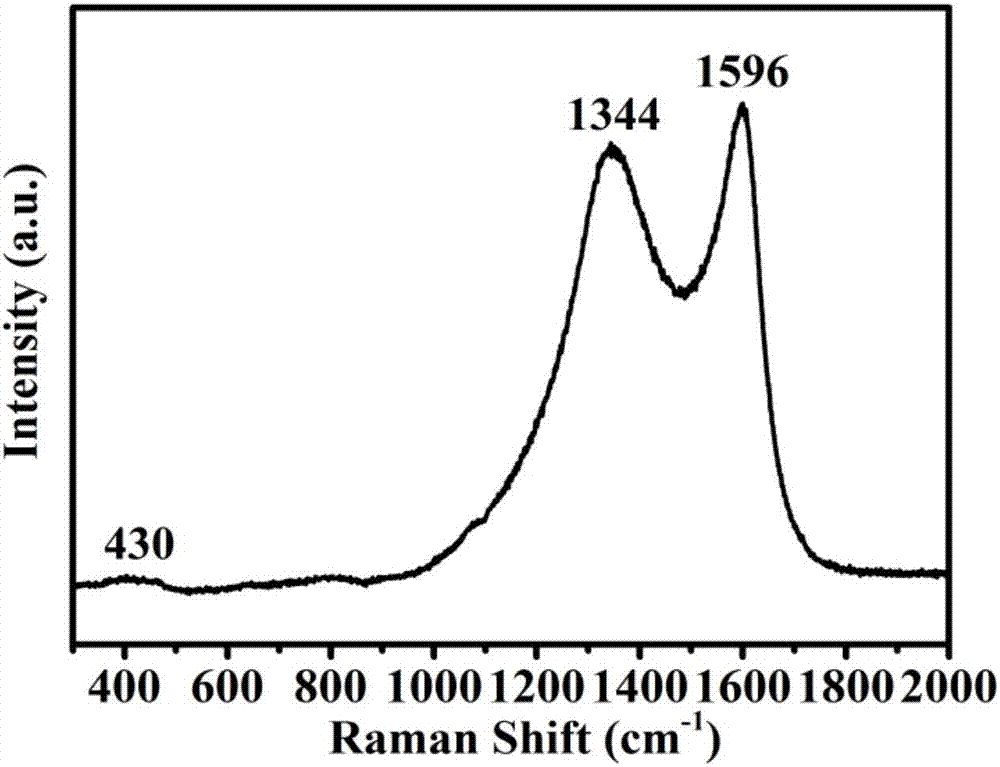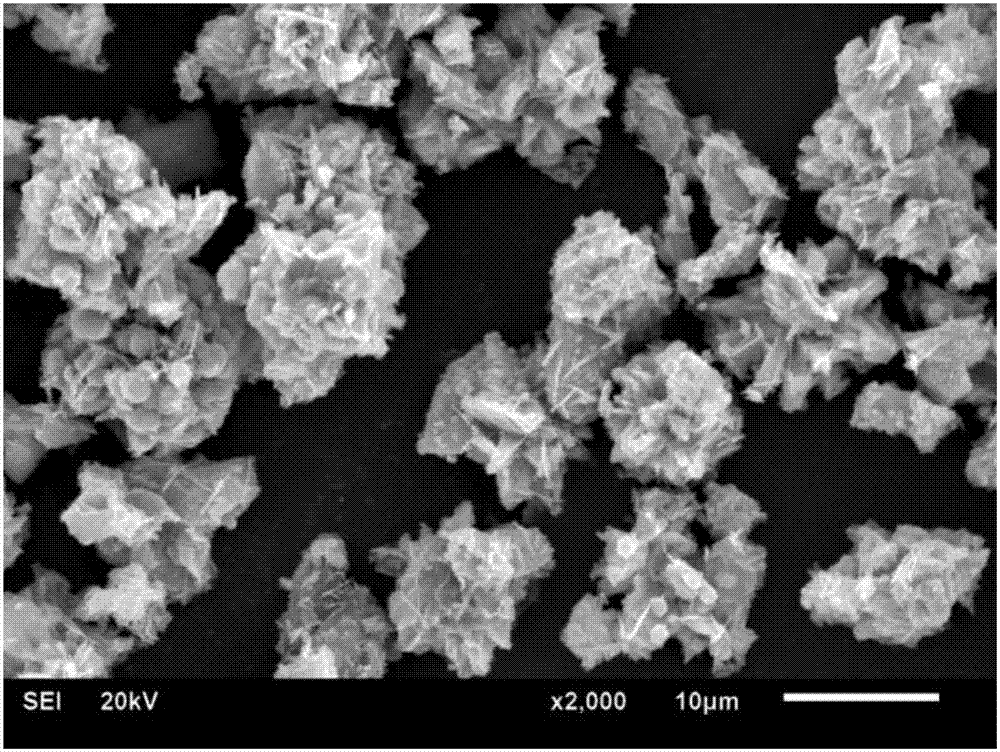Nanometer zinc oxide/porous carbon in-situ composite high-capacity lithium ion battery material and preparation method thereof
An in-situ composite material, nano-zinc oxide technology, applied in battery electrodes, secondary batteries, circuits, etc., to achieve the effect of increasing specific surface area, improving electrical conductivity, slowing expansion and shrinkage
- Summary
- Abstract
- Description
- Claims
- Application Information
AI Technical Summary
Problems solved by technology
Method used
Image
Examples
Embodiment 1
[0028] First, the molar ratio of Zn 2+ :C 6 h 5 o 7 3- Weigh 4.09g of anhydrous zinc chloride and 5.88g of trisodium citrate dihydrate for 3:2, dissolve them in 20mL of deionized water respectively to obtain zinc chloride solution and sodium citrate solution, and mix the two evenly to obtain a mixed solution. Then, the mixed solution with 20 mL of absolute ethanol was placed in a 60°C constant temperature water bath, and kept under stirring reaction conditions for 30 minutes. The obtained reaction precipitate was soaked with absolute ethanol / deionized water for 3 times, and zinc citrate was obtained by freeze-drying. Then put the zinc citrate into the crucible, place it in a horizontal tube furnace, raise it from room temperature to 700ºC at a rate of 5ºC / min under argon gas, keep it warm for 3 hours, and cool it down to room temperature naturally. The final carbonized product is nano Zinc oxide / porous carbon in situ composites.
[0029] The active material is nano zinc o...
Embodiment 2
[0040] First, the molar ratio of Zn 2+ :C 6 h 5 o 7 3- Weigh 4.09g of anhydrous zinc chloride and 5.88g of trisodium citrate dihydrate for 3:2, dissolve them in 20mL of deionized water respectively to obtain zinc chloride solution and sodium citrate solution, and mix the two evenly to obtain a mixed solution. Then, the mixed solution with 20 mL of absolute ethanol was placed in a 60°C constant temperature water bath, and kept under stirring reaction conditions for 10 minutes. The obtained reaction precipitate was soaked with absolute ethanol / deionized water for 3 times, and zinc citrate was obtained by freeze-drying. Then put the zinc citrate into the crucible, place it in a horizontal tube furnace, raise it from room temperature to 600ºC at a rate of 5ºC / min under argon gas, keep it warm for 1h, and cool it down to room temperature naturally, and the final carbonized product is nano Zinc oxide / porous carbon in situ composites.
[0041] The active material is nano zinc ox...
Embodiment 3
[0046] First, the molar ratio of Zn 2+ :C 6 h 5 o 7 3- Weigh 4.09g of anhydrous zinc chloride and 5.88g of trisodium citrate dihydrate for 3:2, dissolve them in 20mL of deionized water respectively to obtain zinc chloride solution and sodium citrate solution, and mix the two evenly to obtain a mixed solution. Then, the mixed solution with 20 mL of absolute ethanol was placed in a 60°C constant temperature water bath, and kept under stirring reaction conditions for 2 hours, and the obtained reaction precipitate was soaked with absolute ethanol / deionized water for 3 times, and zinc citrate was obtained by freeze-drying. Then put the zinc citrate into the crucible, place it in a horizontal tube furnace, raise it from room temperature to 700ºC at a rate of 5ºC / min under argon gas, keep it warm for 2 hours, and cool it down to room temperature naturally. The final carbonized product is nano Zinc oxide / porous carbon in situ composites.
[0047] The active material is nano zinc ...
PUM
| Property | Measurement | Unit |
|---|---|---|
| Diameter | aaaaa | aaaaa |
| Specific surface area | aaaaa | aaaaa |
| Mesopore size | aaaaa | aaaaa |
Abstract
Description
Claims
Application Information
 Login to View More
Login to View More - R&D
- Intellectual Property
- Life Sciences
- Materials
- Tech Scout
- Unparalleled Data Quality
- Higher Quality Content
- 60% Fewer Hallucinations
Browse by: Latest US Patents, China's latest patents, Technical Efficacy Thesaurus, Application Domain, Technology Topic, Popular Technical Reports.
© 2025 PatSnap. All rights reserved.Legal|Privacy policy|Modern Slavery Act Transparency Statement|Sitemap|About US| Contact US: help@patsnap.com



